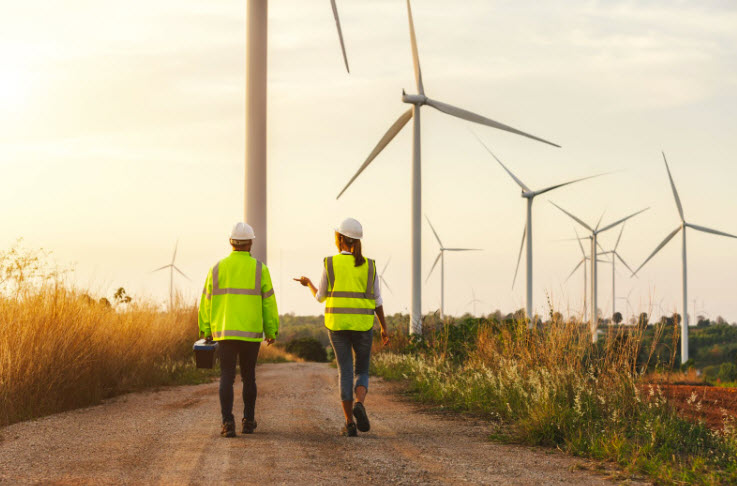The Future of Wind Turbine Technician Jobs: Trends and Innovations Shaping the Industry
Once dubbed, “the hottest job in the US'' by Bloomberg.com, demand for Wind Turbine Technicians continues to enjoy a meteoric rise. Considering the current climate crisis, societal pressure on governments to bolster investments into green energy, and a dwindling supply of non-renewable energy, it’s easy to understand why. Though the job itself is not for the faint of heart or those with an inability to work at heights, these technicians will play a vital role in securing domestic energy supply and keeping the power on. In this article, we’ll examine the current trends of the wind turbine industry, touch on some of the new technologies making their mark.
Current Trends in the Wind Turbine Industry
As we previously alluded to, the demand for wind turbine technicians is considerable. In fact, the latest Global Wind Workforce Outlook 2023-2027 Report, a publication produced by the Global Wind Energy Council in association with the Global Wind Organization, provides a great deal of insight into that demand. The purpose of this report is not only to provide a forecast of the number of technicians that will be needed by 2027, but to also identify opportunities for local and national governments to leverage the growth in the renewable energy sector as they plan for, develop, and execute job training and reskilling programs.

The forecasted number of technicians needed by 2027 - 574,000 - is staggering. Of this number, 43% is expected to be made up of technicians new to the industry, many of which will be responsible for helping to meet ambitious construction and installation targets, or to fill out the operation and maintenance rank and file of the global wind fleet. For someone looking to enroll in a post-secondary program or someone looking to make a career change, the demand and opportunities offered by this industry are more than tempting - for lack of a better term. Considering that the scalability of the global wind energy sector essentially requires that safety training certifications are transferable between companies and even countries, the wind turbine technician workforce is further advantaged as it can remain mobile and agile to opportunities in different markets both at home and abroad.
Legislative changes have accelerated the growth of the wind energy sector. In 2022, the Biden Administration signed the Inflation Reduction Act (IRA), the most significant climate legislation in US history, into law. While the Act itself contains many different strategies and programs to bolster the American economy and cool inflation, it provides considerable incentives (e.g. funding, programs, etc.) to “accelerate the transition towards a clean energy economy and will drive significant deployment of new clean electricity resources.”. While the IRA has made the United States’ commitment to clean energy clear through the letter of the law, the financial commitment is significant; $369 billion dollars will be set aside over the next ten years to support renewable energy projects, wind turbines and wind farms among them.
Specifically concerning wind energy, the IRA has emphasized the need for offshore wind planning, and looks to facilitate job growth in the wind sector using a four-pronged approach. This includes tax incentives for wind projects up to 2032, a $100 million budget for offshore wind transmission planning, a manufacturing tax credit for offshore wind components, and a plan to develop offshore wind farms in the Gulf of Mexico and the southern Atlantic coast.
Smaller markets, like Canada, are also expected to experience considerable growth in the short term. As of 2024, the Canadian wind energy market size is roughly 18.17 gigawatts. This is expected to increase to 27.75 gigawatts by 2029, a compound annual growth rate of 8.83%. This growth is driven by many of the same factors influencing larger markets, namely a reduction in the cost of wind technologies, investment in new wind projects, and governmental programs and subsidies. Canada’s unique geography makes it an ideal candidate for wind energy generation, something that is made obvious in the fact that wind energy is one of the country’s fastest growing energy generation methods.
According to the Canadian Renewable Energy Association, Canada has over 300 wind energy projects deployed across the country producing energy for the power grid. An additional 39 onshore and offshore projects are planned for the next decade to the tune of US$16 billion. Canada has considerable options when it comes to wind farm sites. Two provinces in particular are expected to draw significant investment in the coming years: Alberta and Saskatchewan. The former is home to the country’s largest wind farm boasting 166 wind turbines and is expected to receive approximately US$8 billion in wind project investments by 2030. Saskatchewan is also expected to be the recipient of considerable investment as the province is working to increase its capacity of renewable energy by 50%, also by 2030.
Technology Advancements and Innovation
If one could claim that there are three pillars responsible for the success of the wind energy industry, legislation and investment capital would certainly represent the first two. The third, and perhaps the most crucial to the industry’s exponential growth, would have to be advancements in technology and innovation.
Consider for a moment how much energy is generated in areas considered “high wind” relative to those that aren’t. While the energy return is undoubtedly worth constructing a wind farm in areas with lots of wind, it can be a difficult sell to develop wind capture infrastructure in places where there are fewer “resources” to capture. It becomes a simple math problem; if the cost of the investment is too significant relative to the expected energy return of a given location, chances are slim that the site will be developed into a wind farm. But what happens when innovative design and advancements in technology reduce the cost or increase net energy capture?
According to researchers following a study by the National Renewable Energy Laboratory (NREL), technology that is currently being developed could result in an 80% increase in wind capture capacity within the contiguous United States, particularly in underutilized areas with little to no wind farm infrastructure. The report further concluded that the innovations studied by the NREL’s researchers can reduce the overall cost of energy generation at virtually all locations across the country which in turn should facilitate the growth of the industry. Some of these innovations included:
- Longer blades, taller towers. In effect, installing longer blades on each wind turbine will significantly increase the energy captured by each turbine. While the length of currently used blades poses logistical problems, the development of a segmented blade will facilitate and reduce the overall cost of transportation. By building each tower taller, the blades can be powered by stronger winds, generating more energy per turbine.
- Specific wind turbines for low power. Much in the same way you can’t shove a square peg into a round hole, there may not be a “one size fits” all wind turbine that is optimal for capturing wind energy in all locations. In fact, developing a low-power turbine that has a larger rotor size relative to the generator may be the most efficient solution as larger rotors will transfer more energy to the generator with each rotation.
- Changes to tower manufacturing. Thanks to advancements in industrial 3D printing technologies, wind turbine towers could be manufactured on site, greatly reducing the manufacturing and transportation cost associated with each turbine tower.
- Wake steering. Controls can be added that allow operators to adjust the tilt/direction of a wind turbine to avoid impacting downline turbines, effectively increasing energy production of 1-2%.
Wind Turbines and Energy Generation - The Sky’s the Limit
Being a Wind Turbine Technician is a challenging yet fulfilling and impactful career. While this job requires workers to possess a certain amount of grit and an aptitude towards physically demanding work, it is one that is vital to ensuring our energy supply remains secure. There are few careers in the energy sector that exhibit as much growth potential as the capture of wind energy. With North America’s vast expanse of suitable wind farms development locations both on and offshore combined with the respective government’s commitment to growing this industry, the sky really is the limit for technicians. If you’d like to be a part of the next generation of Wind Turbine Technicians at home or abroad, start your career by enrolling in George Brown College’s Wind Turbine Technician Program.
